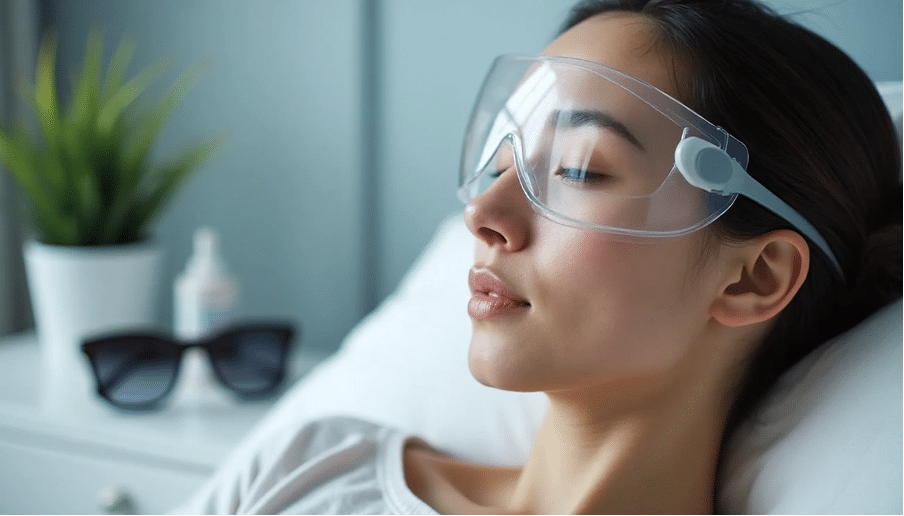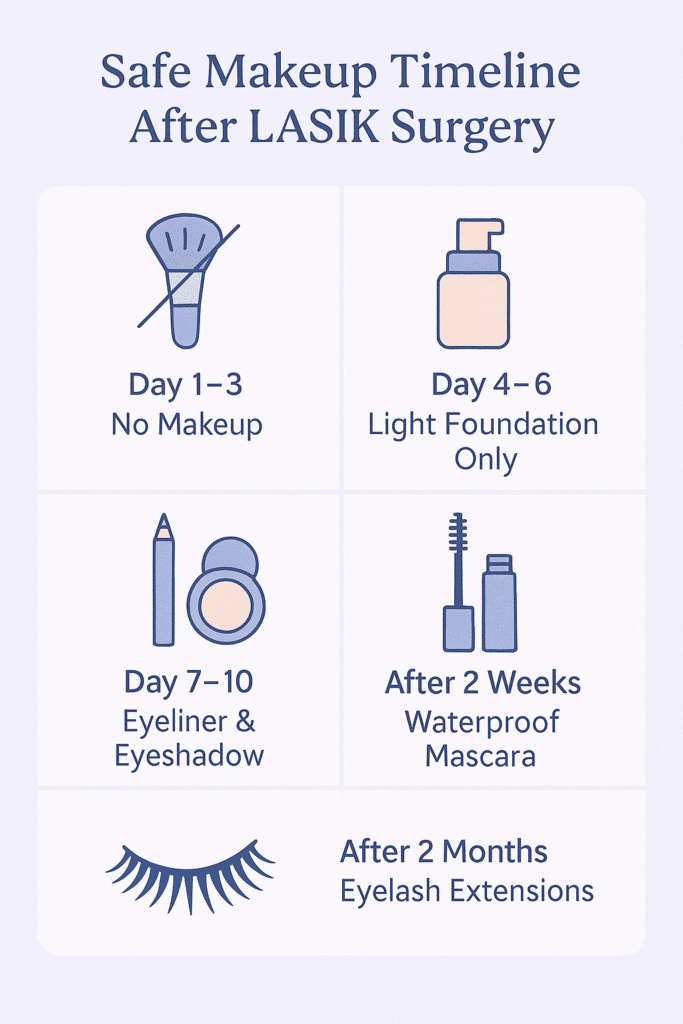Did you know that more than 100,000 laser eye surgery procedures are performed every year in the UK alone? Most patients go back to work within just 24-48 hours after their procedure!
Your laser eye surgery recovery time really depends on how well you protect your eyes in those first vital days and weeks. LASIK surgery usually causes only 4-6 hours of discomfort, but proper aftercare is key to optimal healing. Your eyes need protection after LASIK surgery through several important steps. You’ll need to wear your post LASIK eye shield and use prescribed eye drops to prevent infection. You should also follow specific guidelines about activities to avoid. Good eye care after LASIK can make a big difference in your recovery experience.
This detailed guide shows you the key steps to protect your vision during recovery. You’ll learn everything needed for the best possible results from your procedure. We cover screen time management using the 20-20-20 rule and tell you when it’s safe to get back to your normal activities. This information helps ensure a smooth healing process.

Essential Eye Protection Habits
Proper eye protection is the life-blood of successful laser eye surgery recovery. Research shows your eyes’ blink rate typically drops from 15-20 times per minute to just 5-7 times when you look at screens after LASIK. This decrease affects your healing process, making protection habits essential. Let’s look at the specific steps you need to take to protect your vision during this vital healing period.
Wearing your post LASIK eye shield
The protective eye shield you get after your procedure serves multiple vital purposes. It stops you from accidentally rubbing or touching your eyes, which could disrupt healing or dislodge the corneal flap. On top of that, it keeps dust, dirt, and other particles away that might cause infections or complications.
You should wear your protective goggles:
- Every time you nap or sleep during the first 24 hours
- Each night while sleeping for at least one week after surgery
- Up to one extra week if your surgeon recommends it
This becomes especially important when you sleep since you might touch, rub, or scratch your eyes without knowing. Since no stitches are used to hold the flap after LASIK, the shield protects against damage. Even light pressure on the cornea can affect healing and your final surgical outcome.
Using sunglasses outdoors
Your eyes become much more sensitive to light after laser eye surgery. So, good sunglasses are essential for both comfort and protection. You need to wear the sunglasses from your postoperative kit whenever you step out of the clinic.
Your sunglasses should:
- Block at least 99% of UV light or offer UV absorption up to 400nm
- Have polarised lenses to cut down glare and eye strain
- Fit well around the eye to give protection from the side
You need these sunglasses whenever you’re outside during the first week after surgery, whatever the weather. The need might decrease as you recover, but making this a lifelong habit helps shield against long-term damage to eye tissues.
Avoiding bright lights and screens early on
Your eyes need extra care during the first 48 hours after laser eye surgery. Most surgeons tell patients to stay away from screens during this time. This helps your cornea settle and rehydrate naturally.
Screens affect your eyes in several ways:
- They cut down your natural blink rate
- They expose eyes to blue light and LED white light wavelengths
- They make eyes dry and irritated
To handle necessary screen time after the original rest period:
- Begin with short 5-10 minute sessions
- Follow the 20-20-20 rule: look at something 20 feet away for 20 seconds every 20 minutes
- Use artificial tears often before your eyes get dry
You should also stay away from direct sunlight and bright indoor lighting until your eyes heal fully. Dimmed lights and curtains or blinds can help reduce window glare and make recovery more comfortable.
Precision Vision London’s surgeons give personalised guidance on eye protection based on your specific procedure and healing progress, making sure you get the best results throughout your laser eye surgery recovery.
Stick to Your Medication and Drop Routine
Your laser eye surgery’s success largely depends on how well you follow your medication routine. Precision Vision London’s surgeon will give you specific eye drops that prevent infection and reduce inflammation. Research shows that knowing how to apply eye drops is a vital part of getting the best results during your laser eye surgery recovery.
How to apply eye drops correctly
Eye drops might seem easy to use, but the right technique will give you the best results. Here’s a step-by-step guide that works best:
- Wash your hands with antimicrobial soap to avoid contamination
- Check the expiry date and shake the bottle if needed (this matters most for anti-inflammatory medications)
- Position yourself by sitting or lying down with your head tilted back
- Create a pocket by pulling your lower eyelid down gently with one finger
- Hold the bottle against your nose bridge or forehead, pointing it toward your eye
- Squeeze one drop into the pocket without touching the tip to your eye
- Close your eye for 30-60 seconds and press softly on the inner corner so it absorbs well
- Blot excess liquid with a clean tissue
Many specialists suggest using the “wrist-knuckle” technique during recovery. Make a fist with one hand to pull down your lower eyelid while the hand holding the dropper rests on your knuckles. This gives you better stability and accuracy.
Why timing and hygiene matter
The way you time your eye drops directly affects how well you heal. Your Precision Vision London surgeon might prescribe several types of drops – antibiotics, anti-inflammatories, and lubricants. Each plays a specific role in your recovery.
Antibiotic and anti-inflammatory drops usually need four applications daily for a week. Many patients find it easier to arrange their drops around meals and bedtime. This regular timing helps the medication work better at preventing complications.
You should wait at least five minutes between different eye drops. This lets each medication absorb fully instead of getting diluted by the next drop. Some medications like Prednisolone need shaking before each use to keep the right concentration.
Good hygiene is absolutely vital. Don’t share your eye drops with anyone, and keep the dropper tip from touching your eye or any surface. Most eye drops should be thrown away 28 days after opening unless the label says otherwise. Writing the opening date on the bottle or using coloured labels to tell different medications apart can help you stay organised.
What to do if you miss a dose
Sometimes you might forget a dose despite your best efforts. Take the missed medication as soon as you remember. If it’s almost time for your next dose, just stick to your regular schedule without doubling up.
Missing one dose isn’t usually a big deal, but you need to stay consistent with your medication schedule. Not taking your prescribed eye drops can slow down healing, make you uncomfortable, and might lead to complications.
These practical tips can help you stay on track:
- Keep drops in the refrigerator – they’ll feel better and you’ll notice them more when applied
- Set phone alarms for each dose
- Keep a written record of when you use them
- Use artificial tears between medicated drops to ease stinging and feel more comfortable
Precision Vision London creates your medication plan specifically for your eyes and procedure. Following it carefully protects your eyes after LASIK surgery and helps ensure you get the best possible results.
Avoiding High-Risk Activities
Your laser eye surgery recovery needs careful attention to daily activities that might put your eyes at risk. Our surgeons at Precision Vision London will help you protect your investment in better vision and make sure your eyes heal properly.
No swimming, saunas, or hot tubs
Water can seriously harm your healing eyes after laser eye surgery. You should avoid swimming pools for at least 1-2 weeks after your procedure. Lakes, rivers, and oceans need even more caution – you’ll need to wait 2-4 weeks minimum.
There are two main reasons behind these rules:
- Water might have bacteria that could infect your healing eyes
- Chlorine and other chemicals can hurt your corneal tissue
As with pools, you should stay away from hot tubs and saunas for about 2-4 weeks. Bacteria love the steam and heat, which could mess up your healing process. The doctor will let you know when you can swim again, usually after two weeks. You’ll still need to wear protective goggles for 4-5 weeks. These goggles add extra protection to keep water away from your eyes while they heal.
When to resume exercise safely
You’ll need to ease back into physical activity based on how intense it is:
- First 3 days: Stick to light walking – no other sports or exercise
- After 3-7 days: Light activities like jogging and stationary bikes are okay
- After 1-2 weeks: You can start using light weights at the gym
- After 4 weeks: Most people can safely play tennis, football, and go skiing
- After 6-12 weeks: You can return to boxing, martial arts, and rugby
Watch out for sweat dripping into your eyes during recovery. High-pressure activities that could affect your eyes should wait until after 12 weeks.
Makeup and skincare do’s and don’ts

Your cosmetic routine needs some changes after surgery:
- First 24-72 hours: Keep all cosmetics off your face
- After 3-5 days: Light foundation and concealer are fine, but keep away from your eyes
- After 7-10 days: You can carefully use eye makeup, but skip anything flaky
- After 2-4 weeks: Mascara is okay, but don’t use waterproof types
Throw out all your old eye makeup and brushes to be safe. Bacteria builds up quickly and could cause serious eye infections. Start fresh with new hypoallergenic products made for sensitive eyes. Your face needs extra care too. Skip facial steaming, scrubs, and chemical peels for at least two weeks after surgery. These treatments can be too harsh and might slow down healing.
Reducing Eye Strain at Home and Work
Screen time poses unique challenges while you recover from laser eye surgery. UK professionals often need to return to computer work within days after their procedure. Your eyes need proper care strategies to prevent strain and heal optimally during recovery.
The 20-20-20 rule for screen use
The 20-20-20 rule helps reduce digital eye strain effectively. Look at something 20 feet away for 20 seconds every 20 minutes. This simple habit lets your eye muscles relax and supports healthy tear distribution, which is vital during the early healing phase after your procedure.
Research shows your normal blink rate drops from 15-20 times per minute to just 5-7 times when you look at screens. This dramatic decrease can make your eyes dry, especially since they’re sensitive after surgery. Regular blinking should be your priority – try to complete 10 full blinks every 20 minutes.
Setting up a recovery-friendly workspace
Your workspace setup directly affects how comfortable your eyes feel during recovery. Keep your monitor at eye level and about 20-26 inches away – that’s arm’s length. Tilt your screen down 10-20 degrees to create better viewing angles that reduce strain on your eyes and neck.
Match your screen brightness to your surroundings – it shouldn’t be the brightest thing you see. Blue light philtres help too, especially at night when harsh light might disrupt your sleep. Good ergonomics matter beyond your screen – a chair that supports upright posture prevents extra strain on your back and shoulders.
Tips for reading and using devices
These practical strategies will help you use screens safely:
- Use lubricating eye drops before your eyes feel dry
- Make text bigger and stick to clear fonts like Arial or Calibri
- Step away from screens completely during breaks
- Sleep well to give your eyes extended rest
- Try apps that remind you to blink and take breaks
Precision Vision London’s experts suggest limiting screen time to 25-minute blocks at first, then slowly increasing as your eyes adapt. This method, combined with proper eye moisture, helps manage the screen time most patients need during their laser eye surgery recovery.
Tracking Recovery and Staying in Touch
Your eyes need careful monitoring in the first few weeks after laser eye surgery. This healing period is crucial. Clear vision depends on knowing what’s normal and what needs medical attention. Precision Vision London provides trusted post-op care guidance that gives your eyes the safest path to recovery. Book your post-surgery check-in today.
What to expect in the first week
Most patients feel burning, tearing, and light sensitivity right after surgery. These symptoms usually last 2-4 hours. Your vision should improve within 24 hours, though you might notice some blurriness or changes throughout the day.
These symptoms are normal in the first 48-72 hours:
- A gritty sensation in your eyes
- Mild discomfort or redness
- Increased sensitivity to light
- Watery eyes
Your vision gets better quickly. The eye’s healing happens mostly within the first day 80-90%. Many patients can take light walks by day three. Your vision becomes clearer each day as your eye’s swelling goes down.
Signs of complications to watch for
Complications don’t happen often, but you should know the warning signs. Call your doctor right away if you notice:
- Sudden increase in floaters or flashes of light
- A dark “curtain” moving across your vision
- Sudden blurred vision
- Severe pain that gets worse instead of better
- Yellow discharge from the eye
Remember not to rub your eyes even if they feel irritated. This could affect your healing corneal flap.
Why follow-up care matters at Precision Vision London
Your first check-up happens 24-48 hours after surgery. More visits follow at 3-4 weeks, 3 months, and 12 months. These visits help our surgeons:
- Check if your corneas heal properly
- Test your vision results
- Answer your recovery questions
- Adjust your care plan when needed
Early detection during these visits keeps small issues from becoming bigger problems. Precision Vision London’s complete aftercare programme watches your eye health closely. This gives you the smoothest possible path to clear vision.
Conclusion
The success of your LASIK or LASEK surgery substantially depends on how well you protect your eyes during recovery. Your visual outcomes will improve with proper care during the healing process. Several protective measures will help you achieve the best results. You should wear your post-surgical eye shield to prevent accidental rubbing. Quality sunglasses will protect your sensitive eyes from UV rays outdoors. On top of that, it’s vital to stick to your prescribed medication schedule, especially when you have eye drops. This helps prevent infection and reduces inflammation in those first critical weeks.
Stay away from risky activities like swimming, intense exercise, and eye makeup until your surgeon gives you the green light. The 20-20-20 rule comes in handy when using screens – it keeps your eyes hydrated and reduces strain while they heal.
Most people see dramatic improvements in their vision within 24-48 hours. Complete stabilisation takes several weeks though. Regular follow-up appointments at Precision Vision London will ensure your healing stays on track. Our expert surgeons keep a close eye on your recovery and address concerns before they turn into complications.
The recovery needs patience, but laser eye surgery’s long-term benefits make these temporary changes worth it. Patients who follow these protective guidelines usually heal faster and see better results. Note that what you do in these first vital weeks shapes your final outcome. Proper eye protection isn’t just recommended—it’s essential to your new visual freedom.
Key Takeaways
Proper eye protection during LASIK/LASEK recovery is crucial for achieving optimal healing and visual outcomes. Here are the essential steps to safeguard your vision:
- Wear your protective eye shield whilst sleeping for at least one week to prevent accidental rubbing or contact that could disrupt healing.
- Follow your prescribed eye drop schedule religiously – apply antibiotic and anti-inflammatory drops four times daily for one week to prevent infection.
- Avoid swimming, hot tubs, and saunas for 1-4 weeks as water contains bacteria that can cause serious eye infections during recovery.
- Implement the 20-20-20 rule when using screens: look at something 20 feet away for 20 seconds every 20 minutes to reduce strain.
- Attend all follow-up appointments at your clinic – early detection during check-ups prevents minor concerns from becoming serious complications
Your diligent adherence to these protective measures during the first few weeks directly influences your final visual results and recovery speed.
FAQs
Q1. How can I best protect my eyes after LASIK surgery? Wear your protective eye shield while sleeping for at least a week, use sunglasses outdoors even on cloudy days, and follow your prescribed eye drop routine diligently. Avoid rubbing your eyes and protect them from bright lights and screens in the early stages of recovery.
Q2. What activities should I avoid during LASIK recovery? Avoid swimming, using hot tubs, and saunas for 1-4 weeks after surgery. Refrain from high-impact exercises and contact sports for 4-12 weeks. Also, avoid applying eye makeup for at least a week and be cautious with skincare products around the eye area.
Q3. How can I reduce eye strain when returning to work after LASIK? Implement the 20-20-20 rule: every 20 minutes, look at something 20 feet away for 20 seconds. Set up your workspace with proper lighting and screen positioning. Take regular breaks, use lubricating eye drops, and increase text size on your devices to reduce strain.
Q4. What signs should I watch for that might indicate complications? Contact your doctor immediately if you experience sudden increases in floaters, flashes of light, severe pain that worsens, sudden blurred vision, or yellow discharge from the eye. These could be signs of serious complications requiring prompt attention.
Q5. How long does it typically take to see improvements in vision after LASIK? Most patients notice significant visual improvement within 24 hours, with 80-90% of healing occurring in the first day. However, vision may fluctuate and continue to stabilise over the following weeks. Complete stabilisation can take several weeks to a few months.
Authors & Reviewer
-
 Olivia: Author
Olivia: AuthorHi, I'm Olivia, a passionate writer specialising in eye care, vision health, and the latest advancements in optometry. I strive to craft informative and engaging articles that help readers make informed decisions about their eye health. With a keen eye for detail and a commitment to delivering accurate, research-backed content, I aim to educate and inspire through every piece I write.
-
 Dr. CT Pillai: Reviewer
Dr. CT Pillai: ReviewerDr. CT Pillai is a globally recognised ophthalmologist with over 30 years of experience, specialising in refractive surgery and general ophthalmology. Renowned for performing over 50,000 successful laser procedures.

